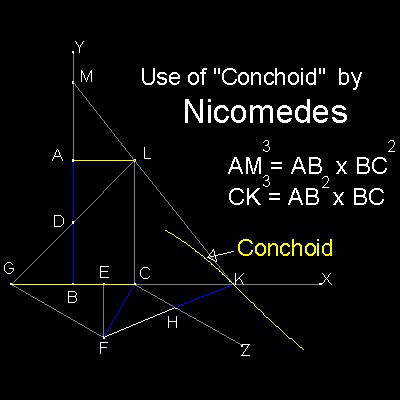
Nicomedes invented a curve named "conchoid" to solve the Delian problem.
It is used to find a point K on X-axis such that line FK passes through
a point "H" on line CZ, and cuts x-axis while HK = CF is being satisfied.
So this process looks similar to "Verging"(neusis) used
by Archimedes, Pappus, and many Greek mathematicians in angle trisection.
Make rectangle ABCL. D,E are mid-points of AB and BC,
Extend LD to produce G on x-axis. Erect EF perpendicular to x-axis
and make CF = AD. Draw CZ parallel to GF.
Choose a point K on x-axs such that HK = CF.
Such a point is the intersection of special curve "conchoid" and x-axis.
This curve can be drawn when F is "pole", CZ is "rule" and CF is "distance".
Alternative is use a ruler marked with length CF on the edge, and
find the location of FK (verging,or neusis process)
Once point K is found, extend line KL to produce point M on y-axis.
Then AM = {AB.BC2}1/3 and CK = {AB2.BC}1/3
|

You can see the process using "conchoid" in animation.
******** Nicomedes_Delian_desc.dwg *******
To create this drawing and animation:
Load Nicomedes_Delian.lsp (load "Nicomedes_Delian")
Then from command line, type test_0
To create this drawing and animation:
Load Nicomedes_Delian.lsp (load "Nicomedes_Delian")
Then from command line, type Nicomedes_Delian
Heath gives the following proof:
First step is to show MD = FK.
Since E bisects BC, BK.KC + CE2 = KF2
(note: recall (a + b) (a - b) = a2 + b2 )
Add EF2 to both sides;
BK.KC + CF2 = KF2 (1)
Since AL is parallel to GK, so is CL to MB,
MA / AB = ML / LK = BC / CK
But AB = 2 AD, and BC = (1/2)GC
Therefore MA / AD = GC /CK = FH / HK
and MD / DA = FK / HK
Here,DA = HK,therefore MD = FK
Since D bisects AB, MD2 = BM.MA + DA2
Combining this with (1) because MD = FK,
BM.MA + DA2 = BK.KC + CF2
But DA = CF; therefore BM.MA = BK.KC
And CK/MA = BM/BK = LC/CK,
Whereas, in triangles MAl & MBK, BM/BK = MA/AL
Therefore
LC/CK = CK/MA = MA/AL
or AB/CK = CK/MA = MA/BC
Then AM = {AB.BC2}1/3 and CK = {AB2.BC}1/3
|
All questions/suggestions should be sent to Takaya Iwamoto
Last Updated Nov 22, 2006
Copyright 2006 Takaya Iwamoto All rights reserved.